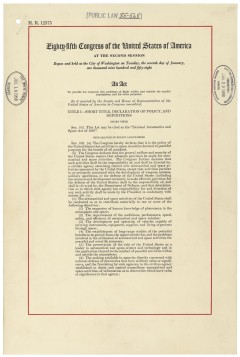To tell you everything about the UV field would be difficult. I could go all the way back to the turn of the 19th century and tell you everything, but I don’t think we’ll have to go there. When NASA was formed by an act of Congress in 1957, Congress provided a mission statement, which included, among other things, the charge to think about scientific applications of space. So, we started thinking about what science applications there might be. There were several scientists who were leaders at that point. Perhaps the most influential was a man named Lyman Spitzer, Jr., a professor at Princeton University who is regarded as the “godfather of the Hubble Space Telescope.”
NASA’s Beginning: Before the National Aeronautics and Space Act of 1958, space exploration was primarily a military venture. On July 29, 1958, when the Space Act was signed by President Dwight D. Eisenhower, the United States established a civil space program that would be run by a new agency, the National Aeronautics and Space Administration, NASA. The Act charged NASA with eight objectives, six of which are listed on the first page of the Act seen here, including “the establishment of long-range studies of the potential benefits to be gained from, the opportunities for, and the problems involved in the utilization of aeronautical and space activities for peaceful and scientific purposes.”
Credit: National Archives and Records Administration
One of the things realized very early on is that a large portion of the energy coming from stars is being radiated by hot stars in spectral regions that you can’t access from the ground: ground observation of astronomical objects contain no light below 3,000 Ångstroms, or 300 nanometers if you want to use those units. That’s a good thing, because we would all get horrible sunburns if that radiation were not blocked by the ozone layer. It was recognized that in order to see this radiation, you needed to get above the atmosphere, and this really was a driving force behind the early ultraviolet astronomy experiments.
It was also understood that if ultraviolet radiation could be detected, then it could be used to measure how many atoms and molecules were in the super low-pressure gas between stars, also known as the interstellar medium. The absorption lines that occur in interstellar atoms appear primarily in the ultraviolet. An early NASA satellite, called Copernicus, designed by a group of scientists led by Lyman Spitzer, made some of the earliest measurements of the gas between the stars.


